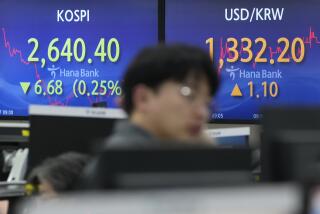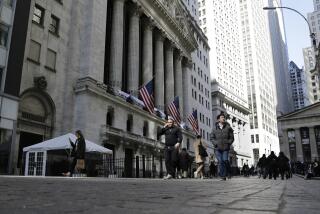Which Way to Wealth?
Most mutual fund investors know the drill. As you’re signing away those first dollars to a fund you’ve just chosen, two fingers on your other hand are crossed.
How can you be sure you haven’t picked a loser? At the very least, how do you know that your fund will perform better, over time, than the stock market average--the minimum return you deserve?
The short answer, of course, is you can’t know. And as hundreds of thousands of new investors have jumped into stock funds over the last 18 months, handing record sums to fund managers, concern about relative performance has been rather muted: The market overall has been such a wild party that few fund owners could reasonably claim disappointment.
Last year, the average general U.S. stock fund soared 31.1%. In the first six months of this year, despite the market’s pullback in recent weeks, the average fund gained 10.7%, according to preliminary data from fund tracker Lipper Analytical Services.
But how good were those results, really? For all the work and worry that many investors put into picking and monitoring stock funds from within the 3,500-fund equity universe, a far simpler, nearly effortless investment strategy would have served them quite well last year and this year: Just “buying the market,” as represented by the blue-chip Standard & Poor’s 500-stock index.
The S&P;, the most popular broad measure of U.S. market performance, soared 37.5% in 1995, or 6.4 percentage points more than the average stock fund.
So far this year, the S&P; has risen about 10%, counting reinvested dividends. Compared with the average stock fund return of 10.7%, the S&P; return was arguably achieved with a lot less risk than the average fund manager endured in producing only a slightly higher return.
The latest hot streak for the S&P;, and for the mutual funds that now invest solely in those stocks as a way of approximating the index’s returns, has resurrected an old debate that veteran investors know well but often ignore and that newer investors may not yet appreciate.
That debate: Is “active” investing--what most fund managers are paid handsomely to do--worth the cost, trouble and risk, versus simply owning a “passive” portfolio that represents the market as a whole?
Passive, or index, investing in the S&P; gives you a stake in the biggest companies in America, from Exxon to Philip Morris to Sears. They are not, typically, the fastest-growing companies, but they are the businesses that have achieved critical mass and tend to dominate their product markets.
Actively managed stock funds, on the other hand, by definition aren’t content to own a static portfolio of big stocks. They promise, often in so many words, to try to beat the market--to invest in the fastest-growing companies, or the most undervalued companies, or the biggest dividend payers, or some other market niche that may afford above-average returns.
*
Yet in the modern history of investing, reaching back as far as 35 years, the evidence indicates that the majority of stock funds haven’t beaten the S&P; but, rather, have continually lagged it:
* In the 35 years through May 31, only 33% of the funds in existence for that era topped the S&P;, according to Lipper Analytical.
* Over the last 10 years, the figure was a more dismal 21%.
* The last five years provided the most favorable comparison for active managers, as 43% beat the S&P.; But that meant 57% did not.
Worse, those results are skewed in favor of active managers. The reason: “survivorship bias,” as only the results of funds that did well enough to survive over each period are included.
To make the comparison more relevant, consider that an investor who committed $10,000 to an S&P; index fund 35 years ago would have had $366,500 by this spring.
In contrast, the investor who put $10,000 in the average active stock fund 35 years ago would have $336,300 now, or $30,200 less than the index investor.
That difference may not seem catastrophic for the active-fund investor, but if the goal of every long-term investor is a comfortable retirement, every additional dollar earned obviously will be very meaningful in the long run.
What’s more, remember that the average active fund’s return is just that: an average. That means plenty of funds earned much less than that average over the last 35 years. With an index fund, at least you know you can’t do worse than the market overall.
If most fund managers haven’t beaten the S&P;, two questions arise: Why haven’t they? And why do the vast majority of small investors still trust active managers with their money, instead of simply buying an S&P; fund?
Proponents of the “efficient market” theory believe that stock prices at any given moment reflect the rational future expectations for the economy, corporate earnings, interest rates, etc. If the market already “knows all,” it can’t be consistently outfoxed by any investor--or at least not without taking on significant risk by going against what is known at the moment to bet on what will be known, say, a year from now.
Even those who reject the idea of market efficiency concede that no investor has accurately called each market top and market bottom; at those moments, human emotion often blocks rational thought.
Still, some managers have, in fact, beaten the S&P; over long periods, as the Lipper data show and as many small investors know from hype about such market legends as Warren Buffett.
One frequent way to outrun the S&P; has been to own some of the thousands of smaller stocks that aren’t in the index, or at least to own them when they have been red-hot, as happens periodically.
Indeed, just three years ago some analysts were predicting the death of S&P; indexing: From 1991 through 1993, smaller stocks soared, coming out of the 1990 bear market, while the S&P; lagged.
Nearly 60% of active funds beat the S&P; in 1991, 59% in 1992 and 65% in 1993. At the end of 1993, the five-year return on the average general stock fund was 98%, compared with 88% on S&P; funds.
But with last year’s explosive gains in blue-chip stocks, only 16% of active managers beat the S&P; in 1995. This year, thanks to the spring surge in smaller stocks, active managers were beating the S&P; handily--until the last few weeks, as smaller stocks have tumbled while the S&P; has held up.
*
Yet no matter how good an account of itself S&P; indexing presents over short or long periods, most small investors seem uninterested in embracing it. Less than 5% of general U.S. stock fund assets are in S&P; index funds.
Many institutional investors index considerably more of their assets, but “the public has rejected indexing,” argues Michael Lipper of Lipper Analytical.
Vanguard Group Chairman Jack Bogle, who has long preached indexing, thinks the message just hasn’t reached enough ears.
“Indexing is now much more than an artistic success,” he says. “It has clearly succeeded.”
In addition to assuring oneself a market return, there are intrinsic advantages to the buy-and-hold index strategy, Bogle notes. Index funds don’t run up high trading costs, because they don’t zip from stock to stock. Vanguard’s S&P; index fund costs 0.2% of assets a year to operate, while some active funds’ costs total 1.5% to 2% of assets--which comes right out of shareholders’ return.
Also, index funds’ low turnover means they aren’t realizing heavy capital gains each year but, rather, allowing gains to build up tax-deferred--a benefit for investors who hate paying that annual tax bill.
Still, human nature works against choosing indexing. After all, there is no real skill involved, and it requires investors to settle for returns that are mediocre (another word for “average”).
Understandably, many investors want to believe that they are smart enough to pick funds that will beat the average return over time--as manager Michael Price has done with the Mutual Shares fund, for example, or Charles Albers with the Guardian Park Avenue fund.
*
Some experts believe the best stock fund strategy for individuals is a split ticket.
“I say do both active and index investing,” recommends John Markese, head of the American Assn. of Individual Investors in Chicago.
An S&P; index fund, he says, can be used as an investor’s core portfolio of big stocks. Beyond that, actively managed funds can be used to further diversify, especially into smaller and foreign stocks.
The idea, Markese says, is to hire active managers to add value where they have a better chance of doing so--in markets arguably much less efficient than the widely researched U.S. blue-chip market.
In fact, measured over the last 10 years, 73% of actively managed small-stock funds have beat the Russell 2,000 small-stock index, Lipper says.
But lest anyone imagine that S&P; indexing is universally sanctioned by financial pros, it’s worth noting that there are some legitimate, if short-term, concerns about buying the S&P; today.
Some Wall Streeters fear that the sharp run-up in the S&P; stocks over the last 18 months has left many of them overpriced relative to the companies’ prospects.
“The potential problem is that the largest companies’ [stocks] have done so well,” says Byron Wien, strategist at brokerage Morgan Stanley & Co. “Since many of them are mature companies serving mature markets, it may be difficult to achieve high returns from present levels.”
That raises another issue: Should the S&P; plunge 20% to 30%--a typical bear market drop--are new index investors prepared to ride that out? You have to be willing to take the bad with the good in index funds--the down part of the ride as well as the up part.
John G. Danz Jr., head of Oxford Capital Management in Towson, Md., argues that index funds are no panacea. An individual’s portfolio, he says, should be “like a suit of clothes--tailored to fit the person’s needs.” An index fund may be far too volatile for some risk-averse investors, he says.
Still, for the true long-term, buy-and-hold fund investor, the evidence is compelling: It’s tough to beat simply owning the market.
(BEGIN TEXT OF INFOBOX / INFOGRAPHIC)
Few Funds Beat the Market ...
Most actively managed stock mutual funds have failed to beat the return of the blue-chip Standard & Poor’s Corp. index of 500 stocks, over any long period of time. The percentage of funds that were index-beaters over four time periods ended May 31:
5 years 43%
10 years 21%
25 years 41%
35 years 33%
... But Most Investors Still Try
Assets of S&P; 500 index funds relative to total assets of general U.S. stock funds, as of March 31:
Actively managed funds: $934 billion
S&P; index funds: $44 billion
(total pie: $978 billion)
Source: Lipper Analytical Services Inc.
More to Read
Inside the business of entertainment
The Wide Shot brings you news, analysis and insights on everything from streaming wars to production — and what it all means for the future.
You may occasionally receive promotional content from the Los Angeles Times.










